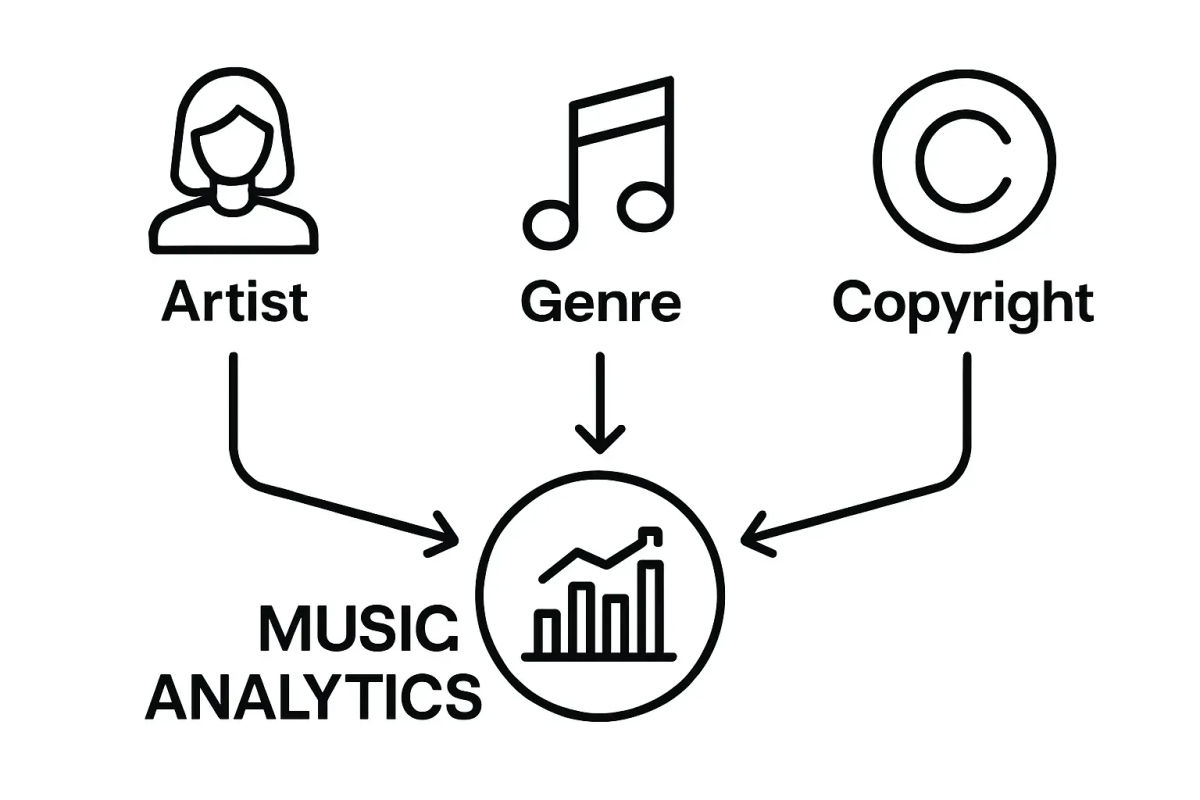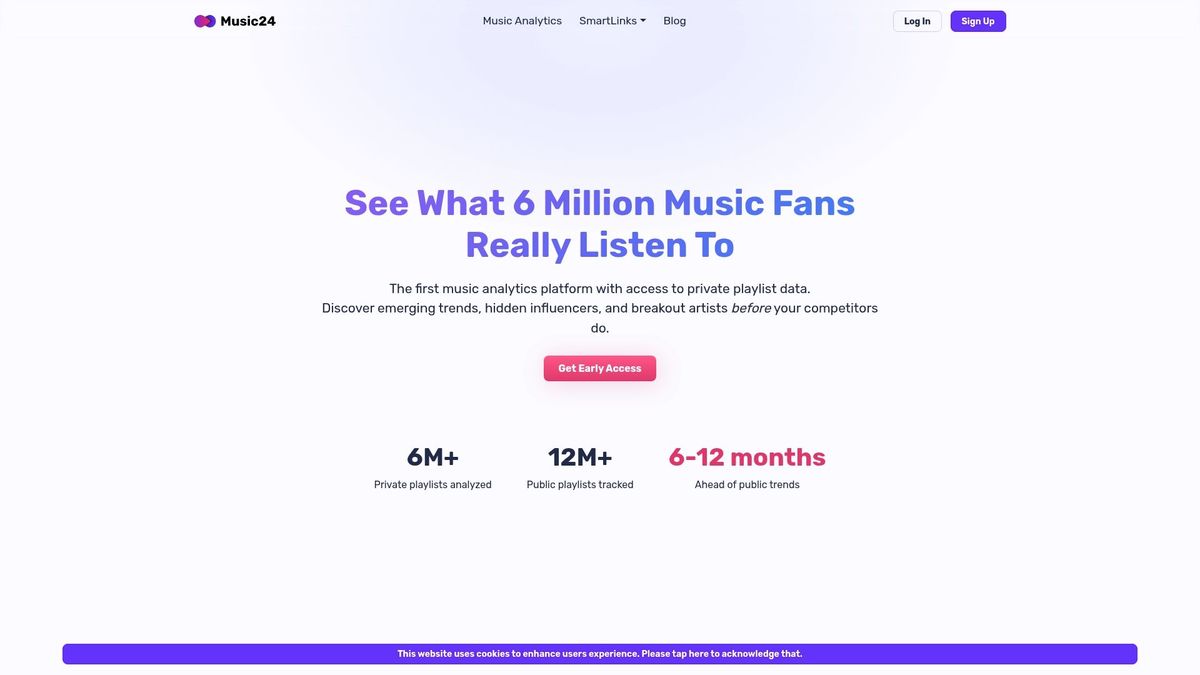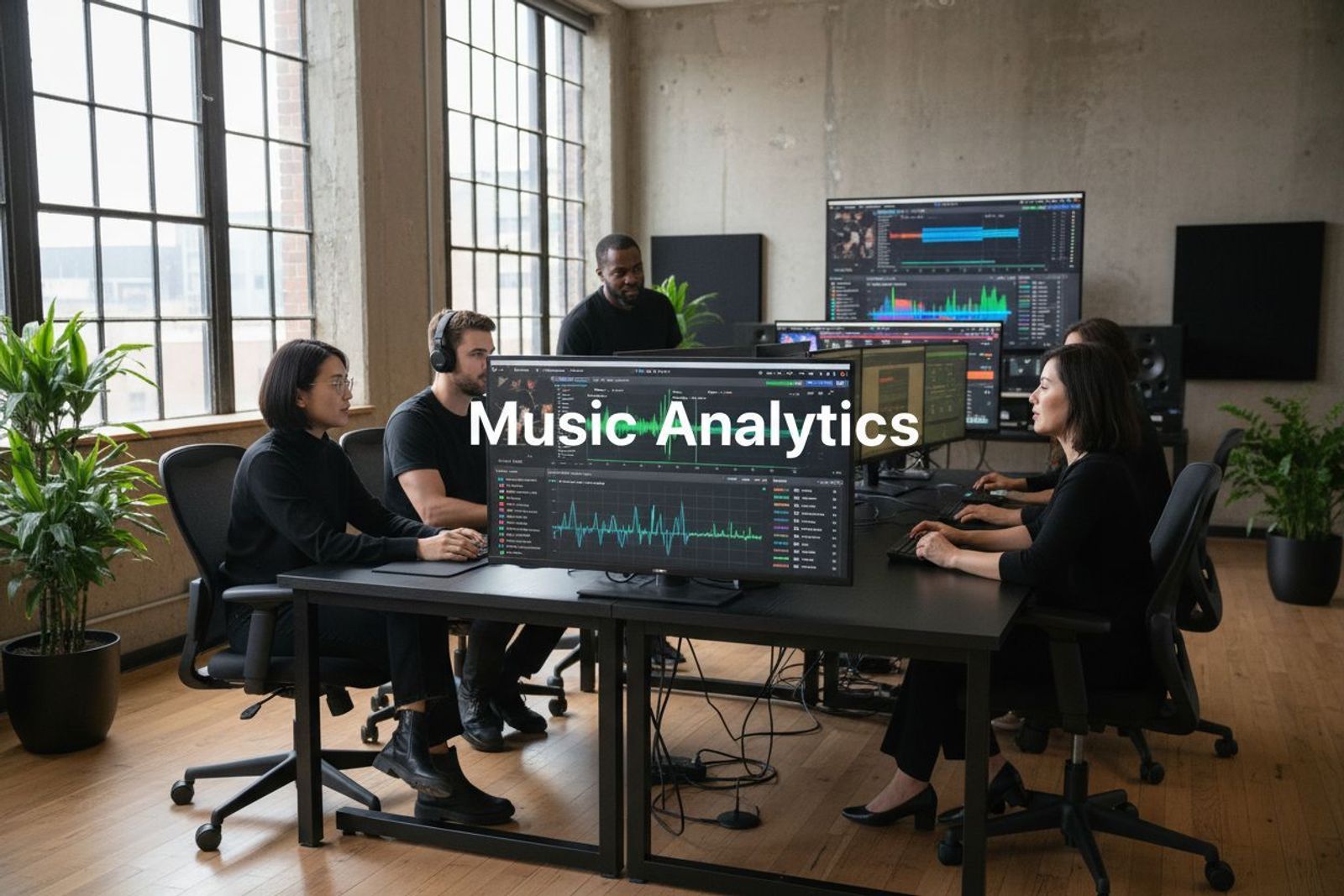Music analytics is built on a hidden layer called metadata. Think of it as the digital DNA that tells the story behind every track and artist you hear. Now here’s where things get wild. Sophisticated metadata parsing can spot breakout stars weeks or even months before anyone else notices. So while playlists and charts scramble to keep up, metadata already knows what fans will love next.
Table of Contents
- Defining Metadata: What Is It In Music Analytics?
- The Importance Of Metadata For Artist And Music Discovery
- How Metadata Influences Music Consumption Trends
- Key Metadata Elements And Their Impact On Analytics
- Real-World Applications Of Metadata In Music Strategies
Quick Summary
| Takeaway | Explanation |
|---|---|
| Metadata enriches music analytics | Metadata includes detailed attributes that enhance insights into music, beyond simple identification. |
| Identifying emerging talent using metadata | Music platforms analyze metadata to detect new artists and trends early, providing a competitive advantage. |
| Data-driven decisions for marketing | By leveraging metadata, professionals can create targeted marketing strategies based on listener preferences and behaviors. |
| Personalized music experiences for listeners | Streaming services use metadata to tailor recommendations, enhancing user engagement through tailored listening experiences. |
| Predicting trends through listener data | Metadata allows industry professionals to anticipate shifts in music consumption, aiding strategic planning in promotions. |
Defining Metadata: What Is It in Music Analytics?
Metadata represents the foundational descriptive information that provides context and structure to musical recordings, enabling sophisticated analysis and understanding of music ecosystems. In music analytics, metadata serves as a complex digital fingerprint that goes far beyond simple track identification.
The Comprehensive Nature of Musical Metadata
At its core, metadata encompasses a comprehensive array of digital attributes associated with a musical recording. These attributes include fundamental details such as artist name, track title, album information, and release date. However, modern music analytics requires a much deeper understanding of metadata that extends into nuanced domains.
A complete metadata profile might incorporate:
- Technical Specifications: Audio file format, bit rate, duration, recording quality
- Performance Metrics: Streaming counts, listener demographics, geographic popularity
- Rights Management: Copyright information, publishing credits, licensing details
Structural Role in Music Discovery and Analysis
Metadata functions as a critical infrastructure for music industry professionals, transforming raw musical data into actionable insights. By categorizing and tagging musical content with precise descriptors, music analytics platforms can generate sophisticated recommendations, track emerging trends, and predict potential breakout artists.
Professionals use metadata to understand listener behaviors, genre crossovers, and cultural music shifts. The granular information allows record labels, artist managers, and marketers to make data-driven decisions about artist development, playlist curation, and targeted marketing strategies.
For those seeking deeper insights into how metadata powers music industry analytics, our guide on understanding the music analytics workflow offers comprehensive exploration of these dynamic processes.
The Importance of Metadata for Artist and Music Discovery
Metadata has transformed from a simple cataloging mechanism into a powerful strategic tool for artist discovery and music industry insights. By providing rich contextual information, metadata enables professionals to navigate complex musical landscapes with unprecedented precision.
Identifying Emerging Musical Talent
In the digital music ecosystem, metadata serves as a critical mechanism for surfacing and validating new artists. Music platforms use intricate metadata analysis to detect emerging trends, tracking granular details like genre evolution, collaborative patterns, and regional music movements. Research from music analytics experts indicates that sophisticated metadata parsing can identify potential breakthrough artists weeks or even months before traditional discovery channels.
Key attributes that help identify emerging talent include:
- Genre Crossover Indicators: Tracking artists blending multiple musical styles
- Collaborative Network Mapping: Analyzing artist interconnections and emerging partnerships
- Regional Music Movement Signals: Detecting localized musical innovation
Strategic Decision Making for Music Professionals
For record labels, artist managers, and A&R teams, metadata provides a comprehensive lens into listener preferences and market dynamics. By analyzing detailed metadata profiles, professionals can make informed decisions about artist development, marketing strategies, and playlist curation.
Metadata enables predictive modeling that goes beyond surface level metrics. It allows industry professionals to understand subtle shifts in listener behavior, predict potential genre trends, and identify niche audience segments that traditional analytics might overlook.
Explore our comprehensive guide on understanding music discovery beyond social metrics to gain deeper insights into how advanced metadata analysis transforms music industry strategies.
How Metadata Influences Music Consumption Trends
Metadata plays a transformative role in understanding and predicting music consumption patterns, serving as a critical lens through which industry professionals comprehend listener behaviors and emerging musical preferences.
Personalization and Listener Experience
Modern streaming platforms leverage metadata to create highly personalized listening experiences.
By analyzing detailed attributes such as genre, mood, tempo, and historical listening patterns, these platforms can generate sophisticated recommendations that go far beyond simple genre matching.
Research on digital music consumption demonstrates that metadata-driven personalization can significantly influence listener engagement and discovery. Key personalization strategies include:
- Contextual Matching: Recommending music based on time of day, activity, or emotional state
- Micro-Genre Exploration: Introducing listeners to nuanced sub-genres aligned with their preferences
- Cross-Cultural Musical Connections: Bridging musical styles through sophisticated metadata mapping
Predicting and Shaping Music Consumption Trends
Metadata serves as a predictive tool that allows music industry professionals to anticipate and potentially influence emerging consumption trends. By tracking granular details like listener demographics, geographic streaming patterns, and cross-genre interactions, analysts can identify nascent musical movements before they become mainstream.
The granularity of metadata enables unprecedented insights into how music consumption evolves. Streaming platforms and record labels can use these insights to make strategic decisions about artist promotion, playlist curation, and marketing approaches.
Dive deeper into understanding music data trends with our comprehensive industry guide to unlock more advanced strategies for interpreting musical consumption patterns.
Key Metadata Elements and Their Impact on Analytics
Metadata represents a complex ecosystem of information that provides critical insights into musical recordings, transforming raw data into strategic intelligence for music industry professionals. Understanding the core elements of metadata is essential for comprehensive music analytics.
Core Structural Metadata Components
At the foundation of music analytics, several key metadata elements play pivotal roles in understanding musical content and performance. These fundamental components provide the structural framework for advanced analysis and insight generation.
Research on digital music information systems highlights the critical importance of comprehensive metadata accuracy. The primary metadata elements include:
The table below summarizes the key metadata components found in music analytics and their primary purposes, providing a clear overview of how each type of metadata contributes to industry insights.
| Metadata Component | Purpose/Description |
|---|---|
| Identification Metadata | Uniquely identifies songs and artists (e.g., artist name, track title, album, unique identifiers) |
| Technical Metadata | Details audio file characteristics (e.g., audio format, bit rate, duration, recording quality) |
| Rights Management Metadata | Covers copyright, licensing, and publishing information |
| Performance Metrics | Tracks streaming counts, listener demographics, and popularity |
| Collaborative Network Mapping | Analyzes connections between artists and emerging partnerships |
| Genre Crossover Indicators | Identifies artists or tracks spanning multiple genres |
| Regional Music Movement Signals | Highlights trends and innovation within specific geographic regions |

- Identification Metadata: Artist name, track title, album, unique identifiers
- Technical Metadata: Audio format, bit rate, duration, recording quality
- Rights Management Metadata: Copyright information, publishing credits, licensing details
Advanced Analytical Metadata Dimensions
Beyond basic structural information, advanced metadata introduces sophisticated layers of analysis that enable deeper understanding of musical ecosystems. These nuanced elements transform metadata from a simple cataloging tool into a powerful predictive mechanism.
Advanced metadata dimensions capture intricate details such as listener demographics, geographic streaming patterns, collaborative networks, and genre crossover indicators. These granular insights allow music industry professionals to develop sophisticated strategies for artist development, playlist curation, and targeted marketing.
Explore our comprehensive guide to music analytics tools to understand how these metadata elements drive strategic decision making in the modern music landscape.
Real-World Applications of Metadata in Music Strategies
Metadata transcends theoretical concepts, emerging as a powerful strategic tool that enables music industry professionals to make data-driven decisions across multiple operational domains. By transforming raw information into actionable insights, metadata drives innovation and strategic planning.
Marketing and Audience Targeting
Research from global intellectual property experts demonstrates that metadata provides unprecedented precision in audience segmentation and targeted marketing strategies. Music industry professionals leverage granular metadata to understand listener preferences, design personalized campaigns, and optimize artist promotion.
Key marketing applications of metadata include:
- Demographic Precision: Mapping listener age, geographic location, and musical preferences
- Campaign Optimization: Designing targeted promotional strategies based on listener behavior
- Cross-Platform Engagement: Understanding audience interactions across different streaming platforms
Artist Development and Resource Allocation
Metadata serves as a critical decision making tool for record labels and artist management teams. By analyzing comprehensive metadata profiles, professionals can make strategic choices about artist development, resource allocation, and career trajectory planning.
Through detailed metadata analysis, industry professionals can identify emerging talent, predict potential breakout artists, and understand nuanced genre evolution patterns. This approach transforms traditional artist development from intuition based methods to data driven strategic planning.
The table below outlines how metadata enhances both marketing strategies and artist development in the music industry, clarifying the operational impact of structured music data.
| Application Area | How Metadata Is Used |
|---|---|
| Marketing & Audience Targeting | Segments listeners by demographics, behaviors, and preferences to optimize campaigns |
| Campaign Optimization | Designs targeted promotional strategies based on detailed listener data |
| Cross-Platform Engagement | Tracks audience behavior across different streaming platforms |
| Artist Development & Resource Allocation | Informs decisions about artist growth, career planning, and allocation of promotional resources |
| Emerging Talent Identification | Predicts new breakout artists and supports early investment |
| Genre Evolution Analysis | Detects emerging trends and micro-genres to guide curation and promotion |

Explore our detailed guide to music data interpretation to unlock advanced strategies for leveraging metadata in music industry decision making.
Transform Your Music Analytics With Private Playlist Insights
Are you struggling to turn music metadata into real-world results? Many professionals face the pain of missing new trends and emerging talent because standard analytics depend on public metrics that are already outdated. The article highlighted how metadata shapes artist discovery and market strategies, but few platforms let you act on those insights before the public catches on.

Take your understanding of metadata to the next level with Music24.com. Harness millions of private playlists to spot genre fusion, rising artists, and influential curators before they make it onto public charts. Experience predictive analytics that reveal music discovery patterns most others cannot see. Start using Music24.com today and unlock actionable data that empowers you to make impactful decisions ahead of the curve. If you're ready to go beyond theory, visit Music24.com now for early access to industry-shaping insights.
Frequently Asked Questions
What is metadata in music analytics?
Metadata in music analytics refers to descriptive information that provides context and structure to musical recordings. It includes attributes like artist name, track title, album information, performance metrics, and rights management details.
How does metadata influence music discovery?
Metadata enhances music discovery by enabling platforms to categorize and tag musical content, leading to sophisticated recommendations and insights on emerging trends and potential breakout artists.
Why is metadata important for artists and music professionals?
Metadata is crucial for artists and music professionals as it helps identify emerging talent, influences marketing strategies, and allows for data-driven decisions regarding artist development and playlist curation.
What are key elements of music metadata?
Key elements of music metadata include identification metadata (artist name, track title), technical metadata (audio format, duration), and rights management metadata (copyright information, licensing details).


